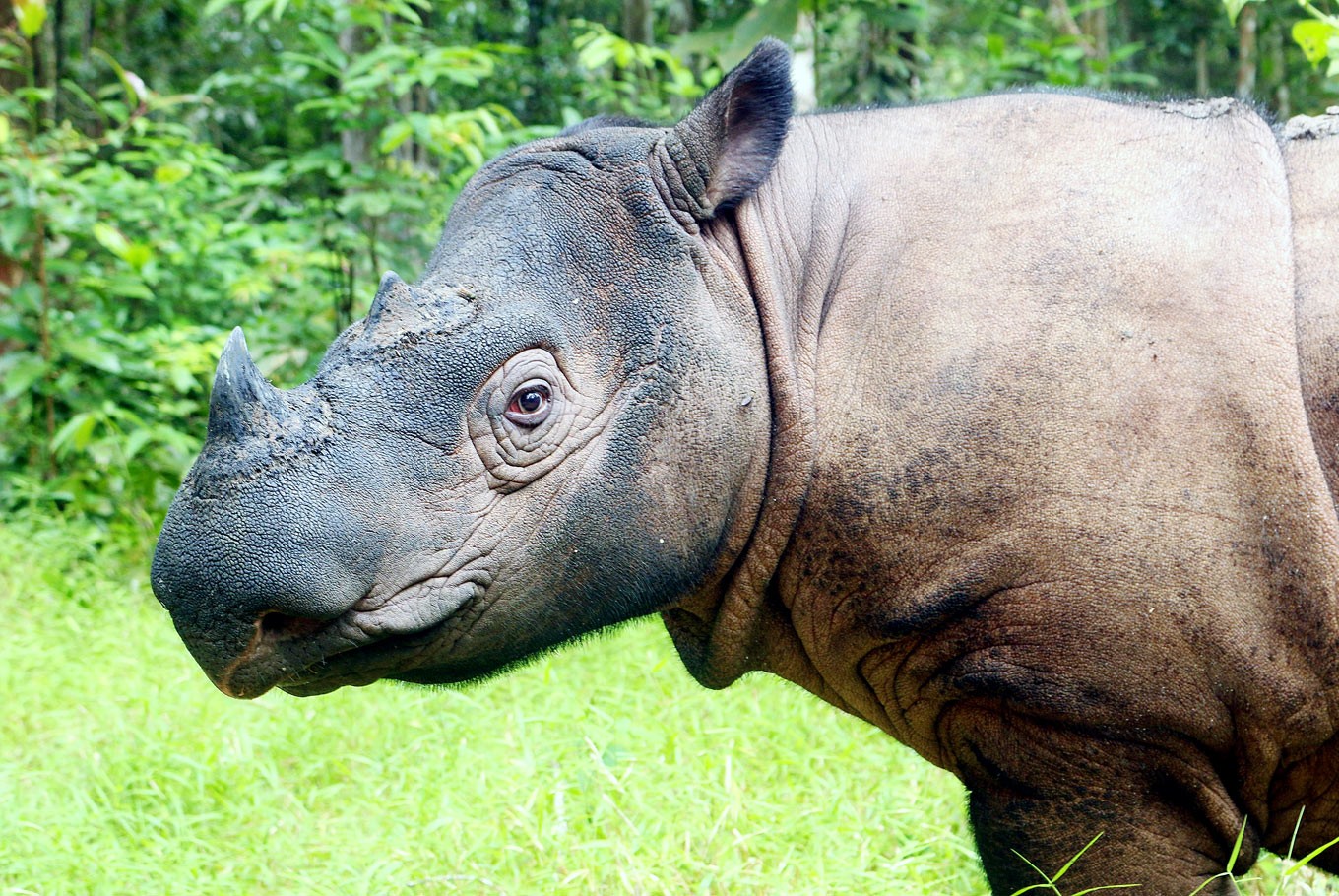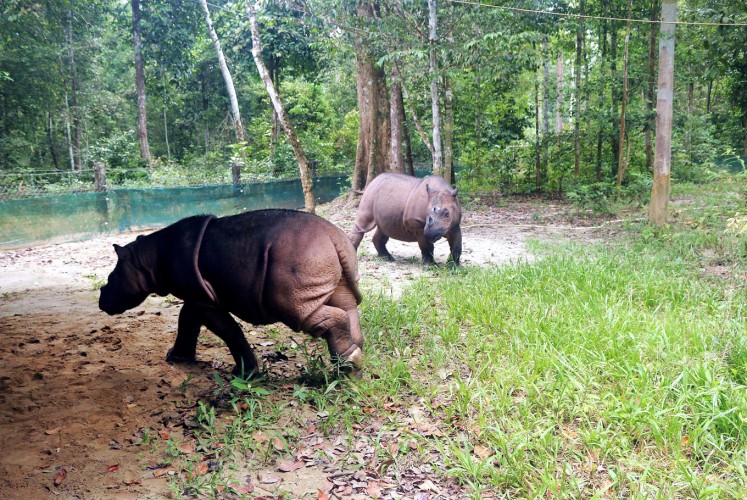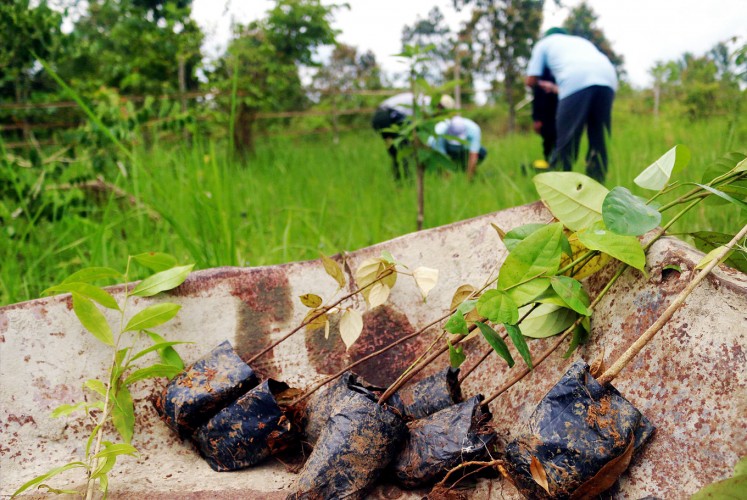Sumatran rhinos' last chance of survival
Change Size
 Hitting puberty: Andatu, a male Sumatran rhino and the older brother of Delilah. (JP/Syafrizaldi)
Hitting puberty: Andatu, a male Sumatran rhino and the older brother of Delilah. (JP/Syafrizaldi)
Delilah, a young female rhino, was leaning against her mother, Ratu, and demanded attention.
The smart calf was playfully running around her mother. Ignoring the baby’s behavior, Ratu guided Delilah back to their enclosed compound.
The rhinos live in a dense forest within the Sumatran Rhino Sanctuary (SRS) at Way Kambas National Park (TNWK) in Lampung province.
The Indonesian Rhino Foundation (YABI) manages the park, where Delilah’s horn markings on tree trunks prevent her from getting lost.
Delilah is now capable of looking for food all by herself, though sometimes Ratu still offers guidance.
“Delilah has also learned to make a mudhole for wallowing in,” SRS-TNWK veterinarian Made Verawati said.
Rhinos are indeed fond of rolling around in mudholes to cool off. The mud also functions as a repellant of bloodsucking, disease-transmitting insects.
In less than two hours, Delilah finished the mud-bathing ritual that morning and left the enclosure to return to the forest with Ratu.
Read also: Sumatran elephant and Kalimantan orangutan born at Batu Secret Zoo
“Rhinos should not interact too much with people; they are sensitive and human presence often disturbs them,” explained Made.

As Made recalled, Delilah’s birth at dawn in May last year was tense.
Delilah was only 20 kilograms at birth but grew quickly. By 10 months old, she had already grown to 270 kg.
Ratu was rescued from poachers in the TNWK in 2005 and lived alone for some time before mating with Andalas, a Sumatran rhino that had been
raised at a United States zoo. Ratu was around 15 years old when she gave birth to Delilah. A female rhino can bear only three to five calves in its lifetime, and has a gestation period of 15 months.
Sumatran rhinos like Delilah and Ratu are currently in a precarious situation, requiring concrete conservation efforts.
Keeping Sumatran rhinos in captivity requires special attention because the species cannot be totally confined and needs a lot of open space to live.
Delilah’s enclosure is a half-open space with fences made from iron and wire. A shelter is provided for health checks and food storage.
The 100-hectare SRS has six enclosures built around the sanctuary, each covering no more than 700 square meters, with the remaining area as space where the rhinos can roam and interact with nature.
In the middle of the SRS, a mating area is provided for the rhinos, which is far smaller than the six enclosures.
Female rhinos are ushered to the area when they show signs of estrus (sexual receptivity). They have a maximum period of fertility of only four days, during which pheromones are excreted.

“Male rhinos can smell the pheromones from several kilometers away. Intensive observations are required to detect the estrus cycle. Their solitary character makes the mating process very fragile,” Made noted.
Delilah and Ratu are two of the seven rhinos currently living in the SRS, the only rhino captive breeding center in Indonesia that aims to release the rare mammals into the wild when possible.
As of now, Delilah and her friends cannot return to the wild because the overall conditions outside the sanctuary are not yet safe.
Outside the sanctuary, there are hunters and recurring wildfires that endanger Delilah and her friends should they be released.
The TNWK is close to the coastal waters east of Lampung, thus allowing open access to the zone. The park’s 1,300-square-kilometer lowland forest constitutes the last habitat expected to restore the population of Sumatran rhinos.
Holistic protection is crucial to increase their population because of their solitary nature.
Sumatran rhinos’ life expectancy is between 35 and 40 years, another factor that makes conservation difficult, according to the communication and outreach manager of the Tropical Forest Conservation Action (TFCA)-Sumatra, Ali Sofiawan.

Routine patrols and monitoring in the park’s natural habitat is therefore a must, and TFCA-Sumatra supports this effort.
“If their relocation is needed, TFCA-Sumatra is ready to assist. Our target is to raise the [Sumatran rhino] population by at least 10 percent,” Ali said.
Up until now, there has been no official data on the Sumatran rhino population.
Ali estimates that there are only 100 Sumatran rhinos currently living in their habitats. They are scattered around the TNWK, the Bukit Barisan Selatan National Park (TNBBS) in Lampung and the Gunung Leuser National Park (TNGL) in Aceh.
“The situation is distressing. Sumatran rhinos are on the brink of extinction. Unless protection is carried out intensively, their fate is no better than the other species that have already been wiped out. Future generations will only see them in pictures or at museums,” Ali said.









